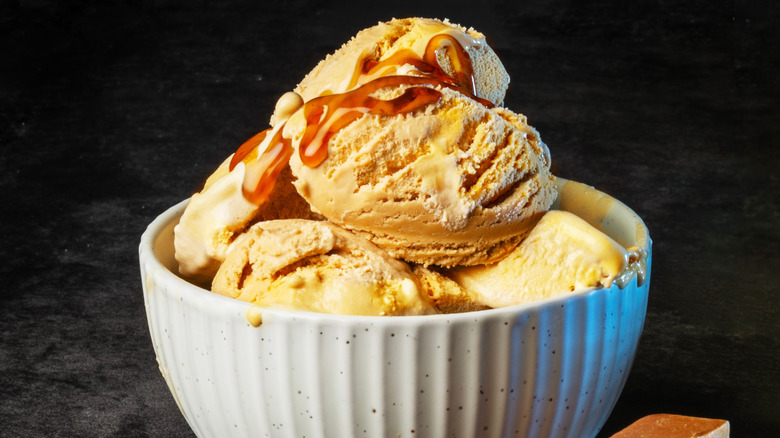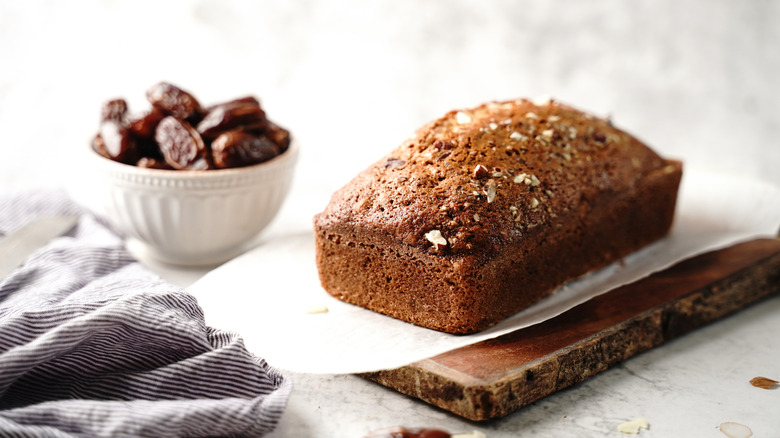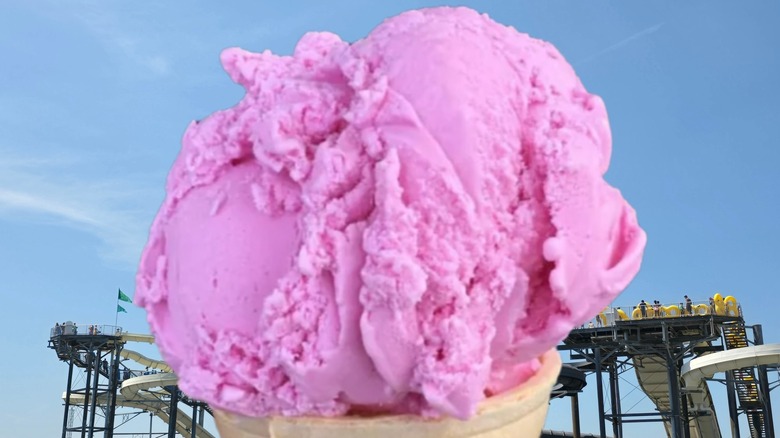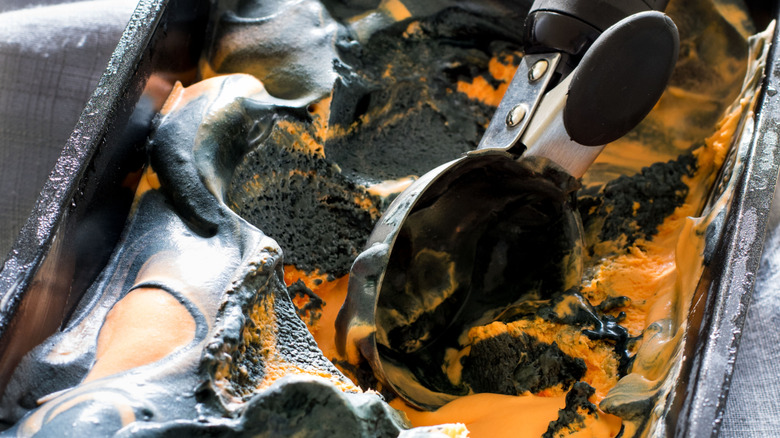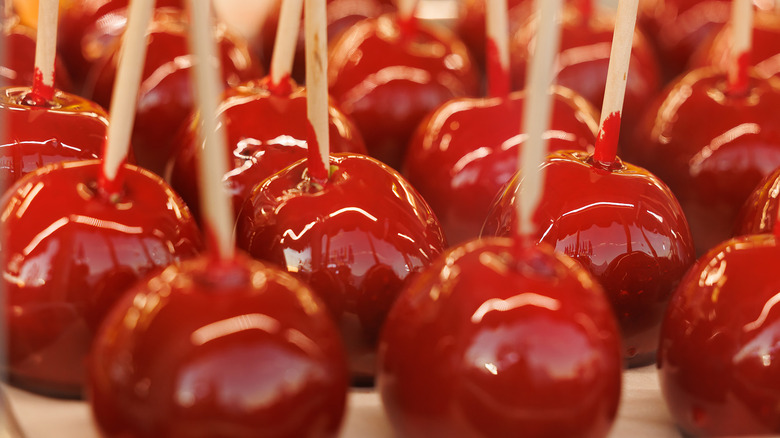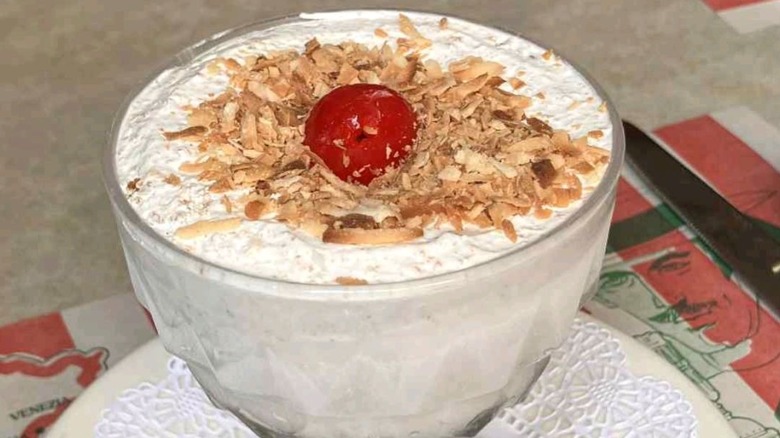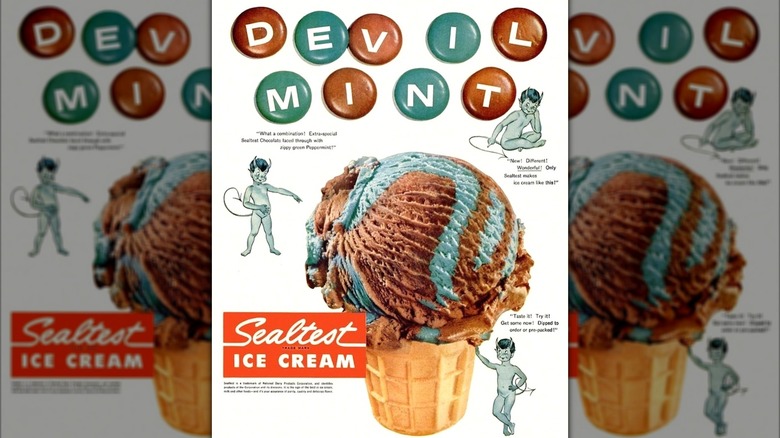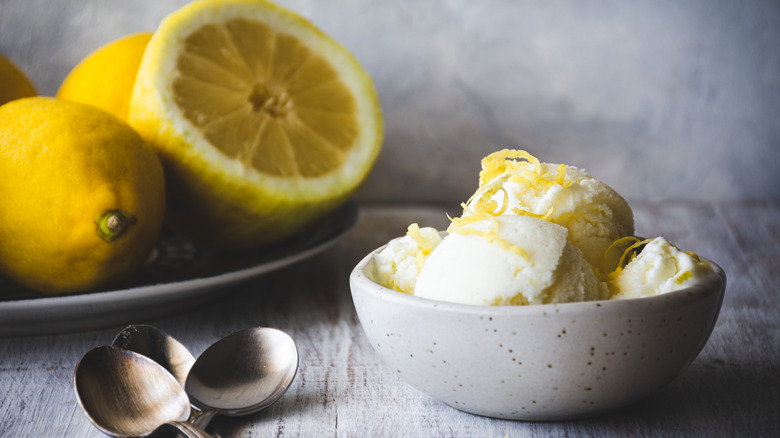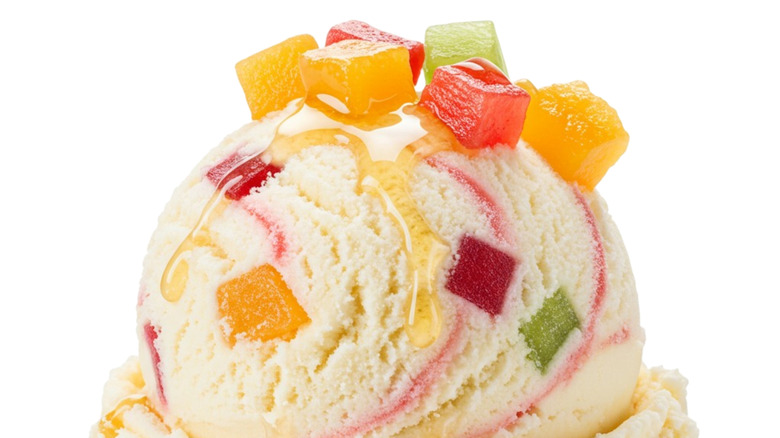13 Old-School Ice Cream Flavors We Wish We Could Find In Stores
The surprisingly long history of ice cream dates back to at least 4000 B.C., when Mesopotamian nobles cooled off during the summer at icehouses that sold flavored ice. Similarly, the ancient Greeks, Romans, Persians, and Chinese all had different versions of frozen treats that eventually evolved into what we enjoy today. In the 1700s, when the tradition of ice cream making reached the colonies that would become the United States, it was instantly beloved by those who tried it.
Americans may not have invented ice cream, but we've certainly innovated it, changing how, where, and even why we eat the confection. Over a century after George Washington bought a mechanical ice cream maker, increasing awareness of at-home production, other enterprising Americans gave us the first ice cream soda, the first ice cream sundae, the first milkshake (originally advertised as a health drink), and the first edible ice cream cup, patented in the 1880s. The waffle cone was introduced at the 1904 World's Fair, and countless varieties of the cold, creamy dessert have come and gone. Sadly, some of the most delicious-sounding ice creams of days gone by are now hard to find. Whether they were among those eaten by royalty centuries ago, or born during the post-refrigeration boom of the 1950s, here are 13 old-school ice cream flavors we wish we could find in stores today.
1. Cold Duck
The rise and fall of Cold Duck ice cream begins and ends with a mistranslation. In the 18th century, at the end of a lavish night, Saxon prince Clemens Wenceslaus Von Sachsen liked to mix the dregs of whatever wines were left into a cocktail of "kaltes ende," or cold ends. Both the story and practice spread, and by the time German immigrant Harold Borgman brought his own version to the U.S. in 1937, the libation's name had changed to "kalte ente," or Cold Duck.
While recipes for classic Cold Duck can vary, they all result in a sweet blend of red, white, and sparkling wine — a perfect match for the tastes of 1950s Americans, who loved fun and fruity batch cocktails like rum punch. Winemakers took note, manufacturing bottled versions of bubbly Cold Duck that flew right off the shelves.
Among the drink's many fans was Irv Robbins of Baskin-Robbins, who suspected that Cold Duck would make a delicious ice cream. It appeared he was right, and after it did well in local markets, Baskin-Robbins took its Cold Duck worldwide, without properly explaining the weird name. When it hit Japan, confused store owners promoted the product by hanging dead ducks, and the resulting outrage spelled the end of Cold Duck ice cream. By the 1970s, demand for the drink had also fizzled out. The refreshing flavor is still possible to find by the bottle, but those looking to grab a tub of dessert are probably out of luck.
2. Butter Brickle
Before you can understand Butter Brickle ice cream, you must first know of Butter Brickle candy, a hard toffee created by the Fenn Bros. Ice Cream and Candy Company of Sioux Falls, South Dakota, around 1918. When early success showed it had a hit on its hands, Fenn Bros. upped the ante by crushing the candies and blending them into buttery ice cream. The unsurprisingly popular result was a textural delight, with a taste reminiscent of caramel or butterscotch.
For years, Butter Brickle was a common ice cream flavor, sold in freezer cases and scoop shops nationwide. The company also trademarked chocolate-coated toffee, which eventually became Heath Bars after Fenn Bros. was liquidated and the proprietary Butter Brickle formula was sold to Leaf, Inc. By the time Leaf was itself bought by Hershey in 1996, Butter Brickle had been deemed old-fashioned.
Butter Brickle ice cream is still sold in some ice cream shops and packed into pints by several brands. But it's no longer easy to find in mainstream grocery stores, which is sad news for many craving a creamy, crunchy, nostalgic scoop of the sweet, buttery treat.
3. Date Nut Bread
Dates are an ancient fruit, cultivated as early as 4000 B.C., but before the 1900s, they were mostly unheard of in the United States. Then came the sugar rations of the 1940s. Americans looked for alternative sweeteners, and dates (by then growing in parts of California and Arizona) stepped into the spotlight.
Dates make a rich replacement for candy, but because they come straight from a tree, they're often marketed as a health food. The staggering amount of sugar in dates makes for a confounding snack, at once nutritious and packed with carbs and calories. In date nut bread, which quickly became a popular vehicle, the fruit's intense sweetness is balanced by other wholesome ingredients.
While we don't eat ice cream because we think it's good for us, Baskin-Robbins saw something in the trendy, healthy-ish combination of sweet, chewy dates and salty, crunchy nuts. For years, Baskin-Robbins Date Nut Bread was a well-loved ice cream flavor, especially among those who liked to pretend their desserts were healthy. But when trends changed again, leading ice cream lovers into chocolate- and cookie-inspired territory, Date Nut Bread was left behind and eventually disappeared from shelves.
4. Teaberry
In the early 1900s, a Pittsburgh chewing gum maker named Charles Burke invented a new flavor using teaberries, the small, red fruit of the American wintergreen. The creation sparked a craze, and for decades, teaberry was ubiquitous throughout Pennsylvania. Before its popularity peaked in the 1960s, the trend produced teaberry tea, candies, wine, and ice cream, all in vibrant shades of pink.
In its heyday, curious ice cream lovers lined up at local scoop shops to try the novelty treat, especially as they heard about the unusual taste of teaberry ice cream. The flavor isn't reminiscent of tea or berries. Rather, it boasts a distinct herbal note, stronger than mint, and a bit spicy. For fans of teaberry ice cream, the dessert is complex and delicious. They say the flavor makes a more interesting alternative to vanilla in a root beer float. To others, it tastes strangely savory, or even medicinal.
In the second half of the 20th century, the polarizing flavor fell out of fashion, and today, teaberry ice cream can be hard to find. Even in the Mid-Atlantic, where it's still considered a regional delicacy, those looking to sample teaberry ice cream must know when and where to look. We wish we could find it in stores nationwide, if only for the chance to weigh in on public opinion. In the meantime, this old-fashioned flavor can still be enjoyed in Teaberry Gum.
5. Violet
Violet candies, while polarizing, are popular in some parts of the world. Anyone who's tried Parma Violets or Choward's Violet Mints can likely recall the soft, powdery, floral flavor of the purple blooms, and imagine how it would work well in ice cream. Yet, while cooking with lavender and other edible flowers has been on the rise in recent years, violet recipes remain harder to find, and ready-to-eat treats like violet ice cream are harder still. This might come as a surprise, given that violets grow wild in much of the U.S., and that the use of violets to flavor sweets has a long history, dating back to Victorian times.
There's an often-told story from 1890 of the Empress of Austria, Princess Sissi, who reportedly fell in love with violet ice cream while on a shopping trip to Naples. She took a break to relax and refresh at the Caffè Gambrinus, sampled the violet (in flavor and color) dessert, and declared it exceptional. To this day, the cafe sells its famous violet ice cream. However, unless you're willing and able to travel to Italy, you might be out of luck. For whatever reason, it's just not a common flavor for ice cream or anything else stateside.
6. Tiger Tail
Among Canada's lesser-known culinary traditions is Tiger Tail, an orange ice cream streaked with black licorice stripes. While the presence of licorice alone is enough to turn some people off, many enjoy the old-school combination of sweet citrus and spicy flavors. Fans say the nostalgic taste is more complex than others, and there's something to be said for an ice cream you can spot (for its stripes) a mile away.
While the exact origins of Tiger Tail appear unknown, it's safe to say it reached household status in the 1950s. For decades, the orange-and-black ice cream was a mainstay in ice cream parlors in and around the Great White North. Today, it remains a go-to order for Canadians who want something more colorful than standard flavors, and several major brands sell it in grocery stores. But in the U.S., where monochromatic vanilla and chocolate reign supreme, striking Tiger Tail has seemingly fallen out of fashion.
7. Redcurrant
Cultivated as early as 350 A.D., redcurrants are some seriously old-school fruit. They remain a popular ingredient throughout Europe, as do blackcurrants, which were once widely grown in the U.S. But when the plants were found to carry a disease devastating to pine trees, currants were banned stateside. A century later, the ban has been lifted, but redcurrants remain among our lesser-known berries, despite their sweet-tart deliciousness and jewel-like beauty.
One culinary use for currants that Americans are missing out on is pretty and tasty redcurrant ice cream. It's not a flavor you're likely to find at a local scoop shop, even the more adventurous ones, because the fruit itself is hard to find. Before the 1920s, though, that wasn't the case. In fact, in the 1800s, a popular Philadelphia-based women's magazine called "Godey's Lady's Book" published an ice cream recipe that called for only three ingredients: Heavy cream, powdered sugar, and puréed currants. In Victorian days, ice creams like these were typically made in a mold, but we imagine it would work well in modern-day ice cream machines. If you'd like to try it yourself, you can opt to balance the tartness of the berries with creamy mascarpone or white chocolate, or stick with the original. The old-fashioned recipe is still widely shared online, as proof that we once had this delicious flavor at our disposal.
8. Candied Apple
Despite their solid standing as America's most popular fruit, and apple pie's unofficial status as vanilla ice cream's best friend, apple as a standalone ice cream flavor has mysteriously never caught on. The closest we've got are limited-edition flavors launched around the holidays, like an old-fashioned ice cream made by beloved brand of yore, Sealtest, in 1956.
Unlike other fall-inspired apple ice creams, Sealtest's was not marketed to lovers of pie. Instead, the flavor profile was built on another seasonal treat, the candied apple. Invented on a whim in 1908 by American candy maker, William W. Kolb, the original candy apples (not to be confused with caramel apples) were allegedly meant as window decoration. But customers were drawn to the vibrant fall treat, and candy apples have been a fixture of harvest festivals and state fairs ever since.
Sealtest Candied Apple featured a creamy pink base dotted with glossy, bright-red specks of candy coating, making the frozen treat as eye-catching as it was mouthwatering. Unfortunately, neither the ice cream flavor nor Sealtest itself is still around, leaving those of us who long for apple ice cream to continue our fruitless search.
9. Tortoni
A rich, cold dessert that arrived stateside by way of Paris in the 19th century, tortoni was originally a frozen mousse. But when Italian-Americans got their hands on the almond-flavored cream dotted with crushed macaroons and candied fruit, they reimagined it as an ice cream. It quickly became a popular treat, served in family-style red-sauce joints along the East Coast. It typically came in a white paper cup, topped with a maraschino cherry.
By the mid-20th century, tortoni's delicious reputation had spread nationwide, prompting legacy brands like Borden Dairy to launch retail-ready versions of the old-school ice cream flavor. Around Christmastime, 1955, one could stop by their local frozen aisle to pick up a pint of Lady Borden's Holiday Bisque Tortoni, an almond-flavored ice cream filled with festive chunks of red and green pineapple.
Unfortunately, the Lady Borden label has since gone extinct, and with it the widespread availability of tortoni ice cream. Until another company decides to revive the nostalgic flavor, we'll have to head to an old-school Italian-American restaurant to satisfy our cravings for classic tortoni.
10. Plum Nuts
From ice cream cakes to pink plastic spoons, Baskin-Robbins has revolutionized the ice cream industry in many ways. It serves as one of the country's earliest examples of franchising, and is credited with creating over 1,400 flavors since it was founded in 1945. To cut through the inevitable marketing clutter, some of those flavors came with charming stories attached. That's the case with plum nuts, which was reportedly invented on Christmas Eve of 1967 when a man made a crack within earshot of Burt Baskin that the company was "plumb nuts" for thinking of so many eccentric ice cream flavors. But while that's a good story, a little digging reveals that plum nuts already existed as an ice cream flavor.
In 1958, nearly a decade before the joke that Baskin allegedly overheard, rival ice cream brand Sealtest launched its own flavor called plum nuts. The product was advertised using the same play on words, as well as a TV tie-in to the kids' anthology series, "Shirley Temple's Storybook."
What's the truth about the origin of Plum Nuts? We'll probably never know, as neither Burt Baskin nor Sealtest is still around to clarify. Either way, we can all agree that the sweet-and-salty combination of creamy ice cream, peak-season plums, and crunchy nuts sounds like an unbeatable flavor that should return to stores.
11. Devil Mint
Not to be confused with garden-variety Mint Chocolate Chip, Devil Mint was far more daring. It featured a rich chocolate base, possibly inspired by the midcentury popularity of Devil's food cake, swirled with a vivid ribbon of green peppermint. The flavor was created by nostalgic ice cream brand Sealtest, which sold Devil Mint by the scoop in shops and in pre-packed pints.
For years, the family-owned Sealtest Dairy Company had a hold on American consumers. Its rapid innovation and creative marketing gave the public a series of mouthwatering ice cream flavors, with fun advertising posters to match. This, of course, included Devil Mint, whose visuals included a perfectly scooped ice cream cone surrounded by adorable cartoon devils illustrated in mint green.
In its heyday, Sealtest owned and operated ice cream factories around the country, and even had its own branded parlor at Disneyland. Over time, though, the brand changed hands and was eventually bought by a Canadian company. It still exists there, but the line of premium ice creams that once captivated Americans with a sweet tooth is no more. So long, Devil Mint. We hardly knew you.
12. Lemon
From classic lemon bars to lemon meringue pie, the world knows no shortage of popular and delicious lemon desserts. Strangely absent from the usual offerings is lemon ice cream, though that wasn't always the case.
In the 1700s, when ice cream rose to mainstream popularity in parts of Europe, lemon was a common flavor. People enjoyed it as the main ingredient, and also when it was combined with another flavor, like elderflower, cinnamon, or mint. However, in the centuries that followed, lemon became less fashionable. Today, it's a tricky ice cream flavor to track down, even as vintage-style lemon lavender has seen a resurgence in specialty shops.
Trader Joe's shoppers can sometimes find When Life Gives You Lemons Make Ice Cream, which features a creamy lemon base swirled with zest and shortbread crumbles, but you've got to time your search right. The retail chain is known for discontinuing its products, and while this one is available at time of writing, it's vanished before.
13. Tutti Frutti
The phrase translates to "all fruit" in Italian, and the multicolored flavor is as you'd expect: A juicy combination of pineapple, papaya, mango, apricot, grapefruit, cherries, and various other seasonal fruits. In Italy, these ingredients are diced and preserved in brandy to form a compote that's used to flavor desserts like cakes, cookies, and other baked goods. After the delicacy reached the U.S. in the late 1800s, though, tutti frutti became synonymous with two things: Chewing gum and ice cream.
Legend has it, the popularity of tutti frutti ice cream was propelled by an ice cream factory owner in Kentucky who had a daughter nicknamed Toodie. The family's love for the flavor spread outward to reach the entire nation, culminating in a midcentury tutti frutti frenzy. For a time, particularly the mid-1950s, tutti frutti ice cream was everywhere: In local scoop shops, freezer aisles, TV shows, and popular songs by Little Richard, Pat Boone, and Elvis. But decades later, the craze has died down. Nowadays, the fruity flavor is surprisingly hard to find, leaving fans scrambling for a sweet taste of yesteryear.


